 Image search results - "japanchild" Image search results - "japanchild" |

The festival is held along a straight, 800-meter section of San'o Odori Road, a 20-min. walk from Akita Station.In the evening, the main event starts at 6:38 p.m. with a taiko drum-beating performance or minyo dancers on San'o Odori Road. At 7:17 p.m., some 200 kanto are carried into the street to the sound of flutes and taiko drums. At 7:40 p.m. following a brief address by the city's mayor, the performance begins as the kanto are raised all at once.
|
|

Pulling the float, Narita Gion Matsuri
|
|

Children lead the way for a float at Kawagoe Festival.
|
|

Tired from walking, Narita Gion Matsuri
|
|

Lead float with Edo festival music played by children. The names of the children playing are written on the red lanterns hanging above. Kodomo Edo-bayashi yatai 先導 子供江戸囃子屋台
|
|

The procession basically consists of two columns: The Hon-retsu which includes the procession's highest-ranking official called Chokushi. It consists of men. The second and longer column is the Saio-dai-retsu consisting of women.
|
|

The floats were jerked left and right and spun around.At 7:00 p.m., the taiko drum-beating started and the floats left the starting point one by one. The beat of the taiko drums was the same as that in the Nebuta Matsuri. A few men stood on the top of the large Neputa and collapsed the hinged, top portion to clear overhead power lines. The floats were jerked left and right and spun around.
|
|

Kawagoe Festival
|
|

Children dressed for the chigo parade (photo session), Tsukiji Hongwanji, Tokyo
|
|

Magistrate Procession 奉行
|
|

Children's night at Aomori Nebuta MatsuriOn the 2nd and 3rd, the parade is mainly for children who participate by pulling the floats. About 15 large Nebuta floats and some small Nebuta floats for the children are paraded.
|
|

Narita Gion Matsuri
|
|

Narita Gion Matsuri
|
|
|
|

Nice during the day, but more dramatic at night.
|
|
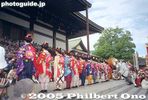
Offering prayers at Narita Gion Matsuri
|
|

Narita Gion Matsuri
|
|

Carp streamer caught at Kanna-machi, Gunma
|
|
|

Hitsujiyama Park with weeping cherry blossoms
|
|

Sumo match with kidsA retirement ceremony for an important sumo wrestler includes a variety of activities besides the actual ceremony of cutting away the topknot. It involves almost the entire Japan Sumo Association, and most wrestlers in the top three divisions (Makushita, Juryo, and Makunouchi) also appear in exhibition matches.
|
|
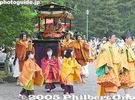
The Saio-dai Princess in 2005 was Saito Ayako, a 21-year-old Kyoto native and student at Doshisha Univ. Her 12-layer juni-hitoe kimono weighs 30 kg. 斎王代、齋藤彩子さん(21)The Saio-dai Princess is selected every year in April and a press conference is held to announce who was chosen. She is always a native of Kyoto, single, and in her early 20s. The Saio-dai was first incorporated in the festival in 1956. In 2005, she is the 50th Saio-dai.
Read more about here.
|
|

Kami shibai storyteller 紙芝居
|
|

A retirement ceremony for an important sumo wrestler includes a variety of activities besides the actual ceremony of cutting away the topknot. It involves almost the entire Japan Sumo Association, and most wrestlers in the top three divisions (Makushita, Juryo, and Makunouchi) also appear in exhibition matches.
|
|

Narita Gion Matsuri
|
|

Lion for good luck.
|
|
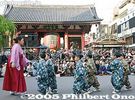
Tokyo Jidai Matsuri 三社大権現祭礼 船渡御
|
|
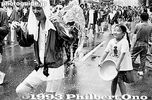
Splash you. This is a day when kids can be mean to grown-ups. This little girl kept filling up her bowl and ran around splashing some unlucky person.I hope that's her school teacher.
|
|
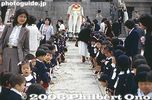
Many little kids held a long rope to pull the white elephant. 昔の築地本願寺の花まつり
|
|
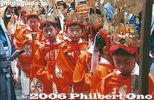
Chigo children 稚児, Nikko
|
|
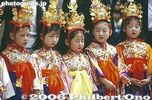
Chigo children. They have two black dots on the forehead and a white stripe on the nose. They don't paint the white stripe today. 昔の築地本願寺の花まつり: 鼻に白い線が塗っている。今は、塗らない。
|
|

Chigo children. 昔の築地本願寺の花まつり
|
|
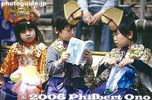
Chigo children. 昔の築地本願寺の花まつり
|
|
|
|

Look at all those Cub Scouts. They don't participate today. 昔の築地本願寺の花まつり
|
|

Kusatsu Shukuba Festival, Shiga Pref.
|
|

Chigo children wearing an elaborate crown with the signs of the eto Oriental Zodiac. NikkoNikko Grand Spring Festival in May.
|
|
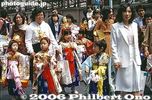
昔の築地本願寺の花まつり
|
|

Lion dance
|
|
|

Children dressed as tekomai, Sanno Festival.
|
|
|

Chigo child
|
|

Kawaii!!
|
|
|
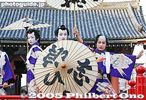
1624: Saruwaka Sanza, Edo Kabuki. Kabuki was started in the early Edo Period in 1624. Later, Edo's three licensed kabuki theaters named the Nakamura-za, Ichimura-za, and Morita-za were relocated to Asakusa in an area called Saruwaka."Sanza" means three theaters. 猿若三座 江戸歌舞伎
|
|
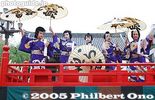
Saruwaka Sanza, Edo Kabuki. "Sanza" means three theaters. 猿若三座 江戸歌舞伎猿若三座 江戸歌舞伎
|
|

Saruwaka Sanza, Edo Kabuki猿若三座 江戸歌舞伎
|
|

The oiran courtesan is escorted by two little girls called kamuro. 花の吉原おいらん道中
|
|

Asakusa Folk Entertainment. Behind the Asakusa Temple, there was a variety of shows, street performers, plays, and other characters. Asakusa has always been Tokyo's entertainment center. 浅草奥山風景
|
|

Tekomai Children, Hie Shrine, TokyoHie Shrine in Tokyo holds the annual Sanno Festival in June. It consists of a parade and ceremony at the shrine. These children are dressed as tekomai geisha who originally provided side entertainment at festivals.
|
|

Hikiyama Festival, Nagahama, Shiga PrefectureHeld in mid-April, the Hikiyama Festival features authentic kabuki plays performed by young boys. Several ornate floats on wheels move around the city to serve as portable stages for these well-trained actors. The boys play both the male and female roles and wear gorgeous kimono. They undergo rigorous practice sessions during the months before the festival.
See more photos of this festival here.
|
|

Asakusa Hana Matsuri 花まつり
|
|

They sang a few songs. Their parents toting video camcorders recorded the event.
|
|

GumQ kids are very well trained.
|
|

Full of pep and vitality. Great for basketball games.
|
|

Yatsu-kaeshi-no-Mai. 八つ換しの舞
|
|

Kodaiko drummers of the small taiko drum. 小太鼓
|
|

Niu Chawan Matsuri, Yatsu-kaeshi-no-Mai. 八つ換しの舞
|
|

Very impressive.
|
|

Many of the dancers wore waraji-related things.
|
|

This girl's homemade happi coat says "Waraji Matsuri."
|
|

Naginata Hoko and chigo child 稚児長刀鉾
|
|
|
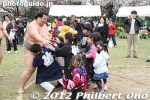
Sumo wrestler with kids at Toshi Nogyo Park in Adachi Ward, Tokyo.
|
|
|
|
|
|

Wrestling with kids amid cherry blossoms from America.
|
|
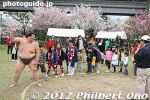
Train around the sumo ring.
|
|
|
|
|
|
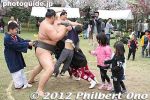
One rascal kid is trying to undo the wrestler's mawashi.
|
|

Special viewing window called "sajiki-mado" at Hino Matsuri. They view the Hino Festival procession from this special window. 桟敷窓
|
|
|

Baby Blessings at Warabi Hadaka Matsuri in Yotsukaido, Chiba. Infants are blessed in front of the shrine.
|
|

A Man and a Baby at Warabi Hadaka Matsuri in Yotsukaido, Chiba.
|
|

Babies to Mud at Warabi Hadaka Matsuri in Yotsukaido, Chiba. The men carry babies to the mud paddy and use a straw strand to paint a dot on the baby. Sometimes they use a finger to do it.
|
|

All the baby-carrying men must be careful not to slip and fall in the mud. Warabi Hadaka Matsuri in Yotsukaido, Chiba.
|
|

Mud Spotting, Warabi Hadaka Matsuri in Yotsukaido, Chiba. The men hold babies and use mud to paint a mud spot on the baby's face. It is to wish for happiness for the baby.
|
|

Mud on Your Face: Fashionable, at Warabi Hadaka Matsuri in Yotsukaido, Chiba.
|
|

Koenji Awa Odori
|
|

Koenji Awa Odori dance, Tokyo
|
|

Kenketo dancer, Shiga
|
|
|
|
|

You can exchange the balls with prizes (more balls = better prizes).
|
|

Kitamachi Awa Odori, Tokyo 写楽連
|
|

Koenji Awa Odori
|
|

Miyako-ren 美奴連(みやこ連)
|
|
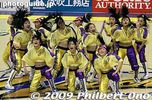
GumQ
|
|
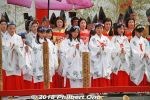
Warawame (童女) daughters of the Imperial family or nobility. They wear chihaya costume. 千早
|
|
|

Flower hat dancers at Naginata Matsuri, Moriyama, Shiga Prefecture.
|
|

Boy drummers.
|
|

Daikon-ren at Nakamurabashi Awa Odori
|
|
|

Shinobu-ren, Nakamurabashi Awa Odori, Tokyo
|
|

Pretty little princess
|
|

Ladder going to the 2nd floor. There's also a trap door on the floor below the ladder where the ninja could hide. Notice the rope. The ninja hiding under the floor would tug the rope connected to the 2nd floor.
|
|

Real ninja obviously did not wear a pink costume, but in the manga/anime world, pink looks cute.
|
|

Karuta Festival. The narrator (standing) recites one of the poems and the contestants must search for and claim the card written with the poem.
|
|
|

Otsuka Awa Odori
|
|

Girl with nabe-kanmuri helmet, Nabe-kanmuri Matsuri, Maibara, Shiga Pref. Known as one of Shiga's more unusual festivals.
|
|

Sagicho Matsuri, Shiga
|
|

A higher view.
|
|

The same man some years before??
|
|

Mikoshi drummer
|
|

Festivals are tiring.
|
|

Taiko drummer
|
|
|

Asakusa Sanja Matsuri
|
|

Placard holders called Waranbe (童部).
|
|

A dance by the Warawame child attendants.
|
|
|

Shrine maidens also danced.
|
|

Group photo of the kids.
|
|
|
|
|
|
|
|
|
|
|
|